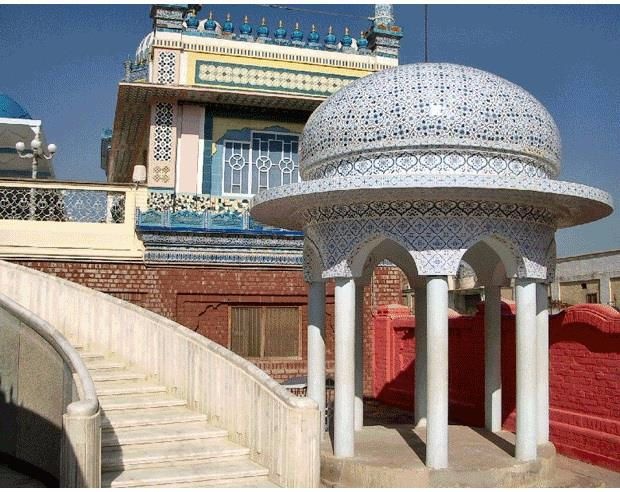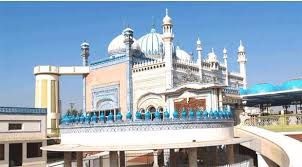Bhong Mosque (Urdu: بھونگ مسجد) is located in the village of Bhong, Sadiqabad Tehsil, Rahim Yar Khan District, Southern Punjab Pakistan. It was designed and constructed over a period of nearly 50 years (1932–1982) and won the Aga Khan Award for Architecture in 1986. The construction of the Masjid (Mosque) was under control of Master Abdul Hameed (kamboh) who worked relentlessly hard for the mosque to make sure it was exquisite and a landmark for Pakistan. A postage stamp depicting it was issued on May 12, 2004 in Pakistan.
The mosque is located at the distance of 200 kilometers from Bahawalpur and 50 kilometers from Rahim Yar Khan and is well known for its exquisite design and architectural beauty with gold leaves carved for the intricate decorative patterns and the stylish calligraphic work.
Sardar Rais Ghazi Mohammad Indhar, a wealthy landlord, commissioned this mosque in 1932 to be the jewel of his new palace compound, which already included a mosque and a prestigious Madrasa (religious school) and was completed in 1982.
Sardar Rais Ghazi Mohammad Indhar, client, designer, patron and landlord conceived, directed and funded the entire building construction. The construction of mosque was carried out by specialists gathered from all over Pakistan and India: master masons from Rajisthan, India; craftsmen from Multan for the glazed tile, mosaic and woodwork; and painters and calligraphers from Karachi. Workshops were set up to train craftsmen in skills that had originally been passed from father to son. Materials and crafts used range from the traditional - teak, ivory, marble, colored glass, onyx, glazed tile, fresco, mirrors, gilded tracery, ceramics, calligraphy and inlay - to the modern and synthetic marbled industrial tile, artificial stone facing, terrazzo, colored cement tile and wrought iron. Sardar Rais Ghazi's intention was to represent as many forms of popular craft and as many Islamic religious architectural features as possible. There has been a recent addition to the mosque. A white marbled Quran has been constructed right outside the veranda.

The interior of the mosque is so shiny and splashing shades and the verses of holy quran are fully embroided on the colourful marbel plates and beautiful templets of the arts made it nice crafted.

Over the 50 years of its evolution, the Bhong Mosque Complex has generated jobs and trained approximately 1000 workers and craft men in indigenous crafts. Its construction laid an edifice for socio-economic development and provision of basic amenities of life including market roads, schools, electricity, gas, bank, hospital, post office etc. to the local population.
Sardar Rais Ghazi Mohammad Indhar, client, designer, patron and landlord conceived, directed and funded the entire building construction. The construction of mosque was carried out by specialists gathered from all over Pakistan and India: master masons from Rajisthan, India; craftsmen from Multan for the glazed tile, mosaic and woodwork; and painters and calligraphers from Karachi. Workshops were set up to train craftsmen in skills that had originally been passed from father to son. Materials and crafts used range from the traditional - teak, ivory, marble, colored glass, onyx, glazed tile, fresco, mirrors, gilded tracery, ceramics, calligraphy and inlay - to the modern and synthetic marbled industrial tile, artificial stone facing, terrazzo, colored cement tile and wrought iron. Sardar Rais Ghazi's intention was to represent as many forms of popular craft and as many Islamic religious architectural features as possible. There has been a recent addition to the mosque. A white marbled Quran has been constructed right outside the veranda.
The construction of the mosque was carried out by specialists gathered from all over Pakistan and India: master masons from Rajasthan, India, craftsmen from Multan for the glazed tile, mosaic and woodwork, and painters and calligraphers from Karachi. Workshops were set up to train craftsmen in skills that had originally been passed from father to son. The mosque's design is a mix of Islamic styles, using rare and traditional materials such as ivory, teak, and onyx, along with industrial elements like terrazzo and artificial stone facing. Broadly eclectic in their use of sources, the builders borrowed stylistic elements from nearby Lahore, as well as Iran, Spain and Turkey, and combined them with Western colonial elements of the 1940s.





